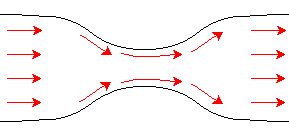Bernoulli's Principle
Daniel Bernoulli, an eighteenth-century Swiss scientist, discovered that as the velocity of a fluid increases, its pressure decreases. How and why does this work, and what does it have to do with aircraft in flight?
Bernoulli's principle can be seen most easily through the use of a venturi tube.
Bernoulli's principle can be seen most easily through the use of a venturi tube.
 |
| Venturi Tube |
The venturi will be discussed again in the unit on propulsion systems, since a venturi is an extremely important part of a carburetor. A venturi tube is simply a tube which is narrower in the middle than it is at the ends. When the fluid passing through the tube reaches the narrow part, it speeds up. According to Bernoulli's principle, it then should exert less pressure.
As the fluid passes over the central part of the tube, shown in Animation or Figure 3-2, more energy is used up as the molecules accelerate. This leaves less energy to exert pressure, and the pressure thus decreases. One way to describe this decrease in pressure is to call it a differential pressure. This simply means that the pressure at one point is different from the pressure at another point. For this reason, the principle is sometimes called Bernoulli's Law of Pressure Differential.
As the fluid passes over the central part of the tube, shown in Animation or Figure 3-2, more energy is used up as the molecules accelerate. This leaves less energy to exert pressure, and the pressure thus decreases. One way to describe this decrease in pressure is to call it a differential pressure. This simply means that the pressure at one point is different from the pressure at another point. For this reason, the principle is sometimes called Bernoulli's Law of Pressure Differential.
Bernoulli's principle applies to any fluid, and since air is a fluid, it applies to air. The camber of an airfoil causes an increase in the velocity of the air passing over the airfoil.
This results in a decrease in the pressure in the stream of air moving over the airfoil. This decrease in pressure on the top of the airfoil causes lift.
This results in a decrease in the pressure in the stream of air moving over the airfoil. This decrease in pressure on the top of the airfoil causes lift.



Comments
Post a Comment